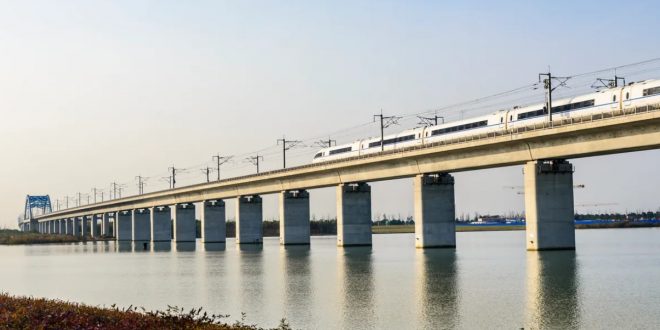There is a wide variety of bridges, ranging from the longest suspension bridge that links Europe and Asia, to India’s innovative bridges constructed from living roots. Nevertheless, the Danyang-Kunshan Grand Bridge in China boasts the distinction of holding both the longest and second-longest bridge titles in the world.
The Danyang-Kunshan Grand Bridge in China is a significant component of the Beijing-Shanghai High-Speed Railway. It serves as a crucial link between Shanghai and Nanjing, making it the longest bridge in the world. This remarkable engineering accomplishment spans an impressive distance of 164.8 kilometers (102.4 miles), passing through various landscapes including rice paddies, lakes, rivers, and urban areas.
The bridge runs alongside the Yangtze River, starting from its mouth in Shanghai. It has an average height of 100 meters (328 feet), but certain sections of the bridge are designed to accommodate ships passing underneath, providing a clearance of 150 meters (492 feet).
The bridge is classified as both a viaduct and a cable-stayed bridge due to its varying length and the diverse terrain it spans. Viaducts are bridges that have a number of towers or arches supporting them beneath the bridge. In contrast, diagonal, tension-straight cables that run from towers above the bridge support cable-stayed bridges.
The Danyang–Kunshan Grand Bridge is of remarkable length, with a sub-section called the Langfang–Qingxian viaduct being recognized as the second longest bridge globally, spanning an impressive 114 kilometers (70.8 miles).
The construction of the Danyang–Kunshan Grand Bridge was completed in 2011, significantly improving railway travel in the area. Previously, the journey from Nigbo to Jiaxing took 4 hours and 30 minutes, but now it can be completed in just 2 hours by train.
The construction of the bridge was an immense undertaking, with a total cost of $8.5 billion. This equates to an average of $51 million per kilometer. The bridge consists of a vast amount of steel, weighing hundreds of thousands of tonnes, and is supported by approximately 11,500 concrete pillars. An impressive total of 2,000 pillars in just one section support the bridge in Suzhou that spans Yangcheng Lake.
The bridge has been constructed with the ability to withstand various natural disasters common to the area, including earthquakes and typhoons. Additionally, it has been designed to endure a direct impact from a navy vessel weighing 300,000 tonnes, ensuring its durability and resilience. The projected longevity of the bridge exceeds 100 years.
The bridge has not only enhanced public transport in the region, but has also become a popular tourist destination, attracting visitors from around the globe who seek to admire the scenic views during the relatively brief train journey.
 Tech Gadget Central Latest Tech News and Reviews
Tech Gadget Central Latest Tech News and Reviews




